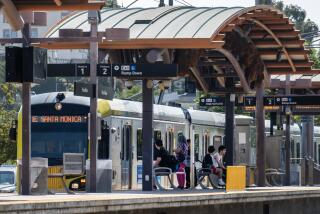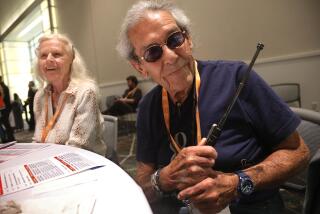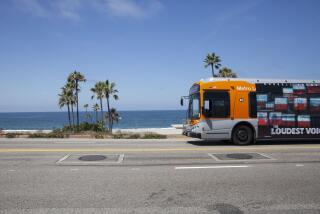Funds for Public Transportation
- Share via
* Nora Zamichow’s July 17 column, “Rethinking Our Transportation Dollars” (special section, The Next Los Angeles) is misleading in its portrayal of national public transportation ridership. Zamichow claims that “nationwide, despite billions poured into erecting elaborate rail systems, fewer and fewer people use public transportation.” The fact is that between 20% and 53% of workers use public transportation in 17 U.S. cities including New York, Washington, San Francisco, Boston, Chicago and Philadelphia.
To further set the record straight, federal transit aid has helped to get people onto mass transit. As the federal transit program matured between 1970-1990, transit ridership increased from 7.3 billion trips annually to almost 9 billion. Admittedly, patronage fell in the last few years, largely due to the job-shrinking recession.
But today, riders are flocking back to buses and trains. National ridership grew by 42 million boarding in the first three months of 1994, marking the third consecutive quarter in which bus and rail patronage has increased. Indeed, several of the “elaborate” rail systems that your article cites have paced the overall ridership surge. For example, patronage of light-rail systems grew 8.3% from January to March of this year, paced by the hugely successful new MetroLink in St. Louis.
Furthermore, your article ignores the major role that immense government parking, automobile and highway subsidies and declining federal transit assistance have played in suppressing transit ridership. Subsidies to the street, highway and free-parking systems have reached more than $300 billion per year. Real federal transit aid declined by more than 50% between 1981 and 1991. Both factors deal a heavy blow to efforts to increase transit ridership.
Zamichow is right, we do need to rethink how we spend our transportation dollars. But instead of decreasing investment for public transportation, we should ask if it is not time that automobile users pay their fair share of the economic and environmental costs they impose on society.
JACK R. GILSTRAP
Executive Vice President
American Public Transit Assn.
Washington
More to Read
Sign up for Essential California
The most important California stories and recommendations in your inbox every morning.
You may occasionally receive promotional content from the Los Angeles Times.










